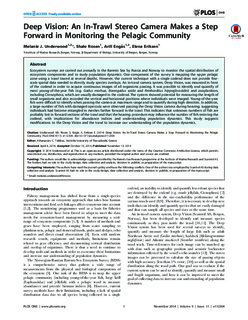| dc.contributor.author | Underwood, Melanie J. | |
| dc.contributor.author | Rosen, Shale | |
| dc.contributor.author | Engås, Arill | |
| dc.contributor.author | Eriksen, Elena | |
| dc.date.accessioned | 2015-01-29T15:06:45Z | |
| dc.date.available | 2015-01-29T15:06:45Z | |
| dc.date.issued | 2014-11-13 | |
| dc.identifier.citation | Underwood MJ, Rosen S, Engås A, Eriksen E (2014) Deep Vision: An In-Trawl Stereo Camera Makes a Step Forward in Monitoring the Pelagic Community. PLoS ONE 9(11): e112304. doi:10.1371/journal.pone.0112304 | nb_NO |
| dc.identifier.issn | 1932-6203 | |
| dc.identifier.uri | http://hdl.handle.net/11250/275066 | |
| dc.description.abstract | Ecosystem surveys are carried out annually in the Barents Sea by Russia and Norway to monitor the spatial distribution of ecosystem components and to study population dynamics. One component of the survey is mapping the upper pelagic zone using a trawl towed at several depths. However, the current technique with a single codend does not provide fine-scale spatial data needed to directly study species overlaps. An in-trawl camera system, Deep Vision, was mounted in front of the codend in order to acquire continuous images of all organisms passing. It was possible to identify and quantify of most young-of-the-year fish (e.g. Gadus morhua, Boreogadus saida and Reinhardtius hippoglossoides) and zooplankton, including Ctenophora, which are usually damaged in the codend. The system showed potential for measuring the length of small organisms and also recorded the vertical and horizontal positions where individuals were imaged. Young-of-the-year fish were difficult to identify when passing the camera at maximum range and to quantify during high densities. In addition, a large number of fish with damaged opercula were observed passing the Deep Vision camera during heaving; suggesting individuals had become entangled in meshes farther forward in the trawl. This indicates that unknown numbers of fish are probably lost in forward sections of the trawl and that the heaving procedure may influence the number of fish entering the codend, with implications for abundance indices and understanding population dynamics. This study suggests modifications to the Deep Vision and the trawl to increase our understanding of the population dynamics. | nb_NO |
| dc.language.iso | eng | nb_NO |
| dc.publisher | Public Library of Science | nb_NO |
| dc.rights | Navngivelse 3.0 Norge | * |
| dc.rights.uri | http://creativecommons.org/licenses/by/3.0/no/ | * |
| dc.title | Deep Vision: An In-Trawl Stereo Camera Makes a Step Forward in Monitoring the Pelagic Community | nb_NO |
| dc.type | Journal article | nb_NO |
| dc.type | Peer reviewed | nb_NO |
| dc.subject.nsi | VDP::Agriculture and fishery disciplines: 900::Fisheries science: 920::Resource biology: 921 | nb_NO |
| dc.source.pagenumber | 8 p. | nb_NO |
| dc.source.volume | 9 | nb_NO |
| dc.source.journal | PLoS ONE | nb_NO |
| dc.source.issue | 11 | nb_NO |
| dc.identifier.doi | 10.1371/journal.pone.0112304 | |

